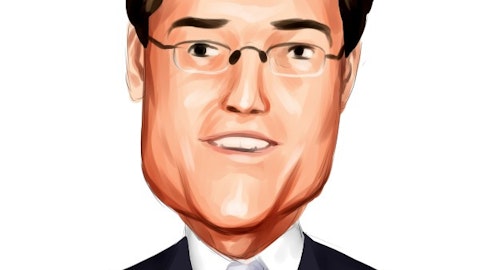What are the best stocks to buy? The Wisdom of Crowds: Why the Many Are Smarter Than The Few and How Collective Wisdom Shapes Business, Economies, Societies and Nations is James Surowiecki’s 2004 book that centers on the idea that the collective estimates of large groups of people are smarter, more accurate than the estimates of any single individual. Surowiecki’s book starts with telling Francis Galton’s story about a competition at a county fair. Eight hundred people tried to guess the weight of an ox that was on display. To Galton’s surprise the average guess (1197 pounds) was mind blowingly close to the actual number (1198 pounds). Surowiecki gives several other examples of this concept throughout his book.
I read this book because, as a PhD student studying the predictive power of insider trading, I observed the same concept in action a few years before the book was published. My research showed that a stock bought by several insiders outperformed the market by a meaningful margin. This result was actually a confirmation of several other studies on insider trading. I don’t want to mislead anyone. Consensus estimates or stock picks work surprisingly well on average but this doesn’t mean that they work all the time.
A few years ago I applied the same theory to the stock picks of hedge funds and found that the consensus stock picks of hedge funds outperformed the market by double digits annually. In fact, the results were even better than the consensus stock picks of corporate insiders. So, we launched an investment newsletter and started sharing the stock picks of this investment strategy in real-time to prove that this is not just a statistical fluke. During the three years since the launch of our investment newsletter this strategy’s stock picks returned 102%. S&P 500 Index managed a gain of only 49% during the same three years. So far this approach of investing seems to be working (see the backtested results).
Follow Jim Simons's Renaissance Technologies
In this article I will share the consensus stock picks of the 4 most successful quant hedge fund managers. Quant hedge funds fundamentally utilize the same principle that was described in Surowiecki’s book. They try to identify several (in some cases dozens of) independent investment strategies by employing dozens of PhDs in several disciplines. None of these strategies work 100% of the time (there is no such thing in investing unless you are robbing people blind) but collectively they generate relatively consistent results. Jim Simons of Renaissance Technologies, David Shaw of D.E. Shaw, Cliff Asness of AQR, and John Overdeck and David Siegel of Two Sigma became billionaires by exploiting this concept commercially on a massive scale. Now, we are going to exploit the collective wisdom of these 4 billionaire hedge fund wizards by identifying the 5 stocks they all had in their portfolios in the latest round of 13F filings. By the way, once a quarter large hedge funds are required to disclose their positions in stocks that trade on major US exchanges. That’s how we get to see and track what they are doing. Based on these filings, here are the 5 stocks stocks that are identified by these billionaire hedge fund managers’ secretive algorithms.
5. Wal-Mart Stores Inc. (WMT)
AQR Capital, D.E. Shaw, and Renaissance Technologies are among the top 10 hedge fund holders of Wal-Mart Stores Inc (NYSE:WMT). Two Sigma had a relatively small position in Wal-Mart which is why WMT entered our list at #5. The biggest smart money positions in this retail giant belong to billionaires Warren Buffett and Bill Gates. Joel Greenblatt’s “magic formula” also sends a strong buy signal for Wal-Mart which lost nearly 21% since the beginning of this year. Wal-Mart’s profitability has been declining and we will be able to this in its 2016 quarterly earnings results more clearly. Exchange rates and increasing wages are the main culprits behind Wal-Mart’s poor performance. One thing positive for the stock is its 3% dividend yield.
Follow Walmart Inc. (NYSE:WMT)
Follow Walmart Inc. (NYSE:WMT)

4. Amgen Inc. (AMGN)
AQR Capital had nearly $400 million invested in Amgen Inc. (NASDAQ:AMGN) at the end of June. This is the third biggest position in Amgen among the 700+ hedge funds tracked by Insider Monkey. Renaissance Technologies ranked 4th, Two Sigma ranked 7th, and D.E. Shaw ranked 11th in terms of their Amgen positions. We don’t why exactly these quant hedge funds piled on Amgen but we know that Amgen’s biggest hedge fund holder is activist hedge fund manager Dan Loeb. Third Point had nearly $1.4 billion riding on Amgen at the end of June. That’s a large amount of money even for these billionaire hedge funds. A year ago in Third Point’s Q3 investor letter Dan Loeb said the following about Amgen:
Follow Amgen Inc (NASDAQ:AMGN)
Follow Amgen Inc (NASDAQ:AMGN)
“Since its founding in 1980, Amgen (“the company”) has been a pioneer in the biotechnology industry, successfully discovering, developing, and marketing therapeutic agents that have meaningfully impacted human health. From 1989 to 2002, Amgen grew five revolutionary biologic drugs into billion dollar blockbuster products in oncology, nephrology, and inflammation. Today, Amgen is a $105 billion market cap company with annual revenues of nearly $20 billion and annual net income of over $5 billion.
Considering this track record, Amgen’s long‐term underperformance relative to its biotech peers is surprising. The company has a compelling mix of long‐duration, high‐margin mature products like Neulasta and Enbrel, and a number of exciting high growth assets, including recently launched blockbusters like Prolia and Xgeva along with innovative latestage pipeline assets like evolocumab. Yet, using nearly any valuation metric, the Company trades at a substantial discount to peers. Amgen even trades at a discount to the US pharmaceutical sector, despite superior revenue and earnings growth rates. Amgen’s current discount to fair valuation – and the lack of structural hurdles to closing this gap –make it an attractive investment opportunity. Third Point is now one of the company’s largest shareholders.
Amgen has all the hallmarks of a hidden value situation, one of our favorite investment themes. The company does not receive proper credit from investors for either the cash generative potential of its mature products or the coming financial impact of its growth assets. In the mature products segment, we believe revenues will be sustainable and concerns about potential erosion are overstated. With respect to Amgen’s pipeline, we believe the market underappreciates how disruptive some of its new products will be. Our conviction about the company’s growth pipeline has been bolstered by our discussions with Third Point’s newly created Scientific and Medical Advisory Board (“SMAB”) led by renowned oncologist Dr. David Agus. Dr. Agus has helped us assemble a world‐class team of scientists and physicians to assist in our evaluation of therapeutic companies and their clinical assets.
We believe the obscured fundamental value and investor skepticism that have led to Amgen’s valuation discount can be easily unlocked. Throughout our due diligence and
discussions with sell‐side analysts and other investors, it became clear that the market has penalized Amgen for several key reasons: 1) its historical lack of R&D productivity; 2) more than a decade of flat operating margins; and 3) the suspension of its share repurchase program in 2013 following its $9 billion acquisition of Onyx Pharmaceuticals.
First, on R&D productivity, our analyses confirm that Amgen’s R&D efforts have been more costly and less efficient than those of its biotech peers. Despite investing a cumulative $32 billion in R&D since 2002, over 75% of Amgen’s current revenues still come from products introduced before that year. Amgen also appears to spend significantly more money on its late‐stage pipeline assets than any of its biotech peers – both in absolute terms and relative to the number of development projects. Given this sparse output versus to investment, we believe improvements are needed in Amgen’s R&D evaluation process, a hypothesis supported by members of our SMAB.
Second, the market has rightfully punished Amgen for having flat operating margins since 2002 despite a 3x increase in revenues, a failure we attribute to excessive spending. For starters, the bloated cost structure is troubling given that Amgen competes in specialized therapeutic areas which require small, highly focused sales and marketing efforts, and generates the majority of its revenues from just a few well‐established, popular drugs. Another puzzle is that while the biotechnology industry has seen substantial improvements in manufacturing efficiency, Amgen has not demonstrated any of the obvious economies of scale (e.g., procurement, sourcing) that should have been realized. Against this backdrop, the company’s lack of operating margin leverage over this period is doubly surprising. Given its revenue growth, we are convinced that Amgen should have seen meaningful operating margin expansion since 2002, a shortcoming which we believe management has now acknowledged. We believe recent efforts to trim costs do not even scratch the potential opportunity.
Third, in 2013, Amgen’s management made a questionable capital allocation decision: the company purchased Onyx Pharmaceuticals at a 40%+ premium for $9 billion in cash while halting its own share repurchase program. At the time, the company said that its buyback would remain halted until 2016. Based on corporate filings, during the deal negotiations, Amgen had concerns about Onyx’s lead compound, Kyprolis, and renegotiated to reduce the price. Since the acquisition closed, Amgen has disclosed that while the ASPIRE trial for Kyprolis met its clinical endpoints, its sister FOCUS trial failed to show clinical benefit and introduced potential concerns over renal‐adverse events. Instead of the Onyx purchase, Amgen could have accretively repurchased over 10% of its shares outstanding, at the depressed valuation of just 4x sales. Beyond Onyx, we question whether the return on Amgen’s $17 billion in M&A spending since 2002 (on top of the aforementioned $32 billion in R&D spending) has been economically justified, both in absolute terms and also relative to other transactions in the sector. We are challenged to identify any “home‐run” acquisitions and, while still early, believe that most of these transactions will turn out to show mediocre returns.
We believe that Amgen management can directly address all three sources of legitimate investor frustration and, based on our discussions to date with management, we believe that they will. While we applauded Amgen’s first steps in July to target the company’s inflated cost structure by rationalizing its US facilities footprint and creating centers of R&D excellence in San Francisco and Boston, we believe much more can and should be done. Immediate actions Amgen can take to create shareholder value include: 1) Focusing its R&D efforts; 2) Providing long‐term margin guidance demonstrating a commitment to reducing a bloated cost structure; and 3) Creating clarity on additional shareholder returns.
We have also asked the company to seriously consider a more radical option, one first proposed by Geoffrey Porges at Sanford Bernstein. It is well‐established that disparate business units generally benefit from operating separately due to distinct corporate cultures, superior efficiencies, and a greater focus for employees and management alike. Given the diverse nature of its assets – cash‐generative Mature Products and R&D‐intensive Growth Products – we believe that Amgen could benefit from a separation into distinct operating units with separate financial statements and should seriously consider separating into two companies (e.g., a MatureCo and a GrowthCo). Internally, each business would have different priorities: MatureCo would focus on efficiency and cash flow, while GrowthCo would emphasize product development and innovation. Externally, each business would be valued with different metrics: MatureCo on a dividend yield and GrowthCo on a peer‐based sales or earnings multiple. Our own extensive diligence suggests that a break‐up of Amgen is feasible and that purported constraints such as tax strategy and supply chain management can be managed.
A separation of Amgen into MatureCo and GrowthCo would likely be very well received by investors. We expect that MatureCo would receive a valuation based on its dividend yield while GrowthCo would be valued, like peers, on a high growth multiple on earnings, reflective of the burgeoning pipeline. Importantly, however, we believe that a separation would not just be good for shareholders, but that it is a more effective way of running each business. In particular, we believe that the benefits to GrowthCo would be the most meaningful: talent retention, more rapid decision making, and ultimately, accelerated development of new therapies to improve countless lives. We urge Amgen management and a committee of independent directors to conduct their own in‐depth evaluation of this strategic option and share their findings with investors.
We believe there are three ways to win in Amgen, depending on the path management takes from here. If Amgen is simply valued at one turn below its pharmaceutical peers at 17x earnings – a change we expect to be driven by management’s current restructuring plans – the stock should be worth $189 per share by the end of 2016. If Amgen fully seizes the opportunities outlined in our recommendations to focus its R&D, announce structural expense reductions, and accelerate capital deployment, we believe 2017 EPS will reach $12.82 (versus consensus of $11.12 currently), implying a share price of $218 on the same multiple. We see the most upside, however, in the scenario where Amgen strategically separates into two standalone business, as we have encouraged management to consider.
In two years, we expect that such a separation could create almost $249 per share in total value, over 80% upside to the current share price.
CEO Bob Bradway and his team have been open‐minded and receptive to our ideas to date and we firmly believe that the company is at an inflection point. The company’s upcoming Analyst Day presents an excellent chance for Amgen management to take bold action and provide clear direction for the company, its investors, and its employees. We hope to maintain our constructive dialogue with management as the company moves towards closing its valuation gap.”
It’s been a year since the publication of Third Point’s investor letter and Amgen Inc. (NASDAQ:AMGN) shares managed to return nearly 9% since the end of September 2014.
3. Microsoft (MSFT)
This is another stock targeted by a high profile activist investor. Jeff Ubben’s ValueAct Capital had more than $3.3 billion invested in the stock. Among our four quant hedge funds AQR had the largest holding valued at $567 million at the end of June. Renaissance Technologies had more than $300 million invested in the stock whereas D.E. Shaw and Two Sigma had $223 million and $16 million respectively. Other hedge fund managers attempted to influence Microsoft’s course in the past (read Einhorn’s speech at the Ira Sohn Conference where he targeted Microsoft), but Jeff Ubben was the one who cut the Gordion’s knot. ValueAct announced a $2 billion stake in Microsoft Corporation (NASDAQ:MSFT) 2.5 years ago when Microsoft shares were changing hands at a dividend-adjusted price of $27. Microsft shares went up 75% since then. Here is what ValueAct said about Microsoft back then:
Follow Microsoft Corp (NASDAQ:MSFT)
Follow Microsoft Corp (NASDAQ:MSFT)
“We believe that Microsoft suffers a similar perception problem to the one that existed when we initially invested in Adobe. The company has long been regarded as a Windows / PC-cycle stock. In fact, just last week, dire predictions about near term PC deliveries spurred another round of terrible Microsoft headlines. “Microsoft Can’t Keep up in a Mobile World,” read the headline in the April 11th Wall-Street Journal. Sell-side analysts focus on Microsoft’s efforts to drive Windows client success in a changing computing world and have become increasingly bearish after the lukewarm launch of Windows-8, which many hoped would revive PCs. Heather Bellini of Goldman Sachs summed up the popular sentiment well in last week’s downgrade: “we think the most important consideration is whether Microsoft can regain share in the total computing market for PCs, tablets and smart phones.” It seems to us that many investors have simply tucked this stock away in the “open when PCs bottom” file and we believe the company is vastly under-owned by institutional investors.
We’ll save you the trouble and be the first to admit that we aren’t nearly smart enough to correctly call the bottom of the PC market, but we also think a singular focus on PCs completely misses the point at Microsoft. At its current valuation, we don’t even need an opinion on PCs. The current valuation at Microsoft exceeds our 10% cash-on-cash requirement giving no credit for Windows!
Instead of looking at Microsoft through the usual PC lens, we look at it through our “plumbing” lens and we like what we see. Nearly 70% of Microsoft’s earnings come from the enterprise-centric business divisions of Server & Tools and Microsoft Business Division (e.g. Office). These businesses derive 60% of revenue from multi-year annuity agreements and have grown EBIT nearly 10% per year over the past five years.
Microsoft sells products that many enterprise customers spend their entire day consuming, such as a knowledge worker sitting in front of Outlook or an IT manager using Active Directory, at a cost that is often as low as $100 per user per year. These products are deeply embedded in the workflow and the enterprise platform agreement is a powerful means to distribute additional products and features that users value such as SharePoint and Lync for collaboration or System Center for IT management.
Microsoft has demonstrated an ability to drive new and premium products into the enterprise customer base and we believe there are plenty of opportunities for them to continue to drive growth. These businesses have already shown a de-coupling from the PC cycle and Microsoft is accelerating the trend with the subscription based pricing of Office 365. Similar to Adobe’s success with “Creative Cloud,” we see the potential for significant migration of Exchange / Office 365 to the cloud, with pricing upside and
positive implications for the way investors perceive and value Microsoft.
Jeff will be making a presentation on Monday in New York City at the Active-Passive Investor Summit and will be featuring Microsoft in his presentation, announcing our investment in the company publicly for the first time. We have attached the PowerPoint deck of slides that will accompany his presentation at the bottom of this letter.”
Please send us an email if you need a copy of ValueAct’s 2013 Q1 investor letter which contains a copy of its presentation (it is too big to upload here).
Microsoft shares performed very well recently despite the worst market turmoil we have seen since 2011.
2. Apple Inc (AAPL)
Apple Inc (NASDAQ:AAPL) is one of the most popular stocks among hedge funds for a long time. Personally I am not a huge fan of the stock and explained why I don’t like the stock as a long-term investment on CNBC 3 months ago. However, quant hedge funds and several high profile investors such as Carl Icahn and David Einhorn love this stock. AQR Capital had nearly $1 billion invested in the stock. D.E. Shaw followed AQR with a $365 million position. RenTech and Two Sigma had $215 million and $31 million respectively in the stock. Carl Icahn said in May that Apple is worth $240. Here is what he said:
“After reflecting upon Apple’s tremendous success, we now believe Apple shares are worth $240 today. Apple is poised to enter and in our view dominate two new categories (the television next year and the automobile by 2020) with a combined addressable market of $2.2 trillion, a view investors don’t appear to factor into their valuation at all. We believe this may lead to a de facto short squeeze, as underweight actively managed mutual funds and hedge funds correct their misguided positions. To arrive at the value of $240 per share, we forecast FY2016 EPS of $12.00 (excluding net interest income), apply a P/E multiple of 18x, and then add $24.44 of net cash per share.
Follow Apple Inc. (NASDAQ:AAPL)
Follow Apple Inc. (NASDAQ:AAPL)
…Considering our forecast for 30% EPS growth in FY 2017 and our belief Apple will soon enter two new markets (Television and the Automobile) with a combined addressable market size of $2.2 trillion, we think a multiple of 18x is a very conservative premium to that of the overall market.
…While our forecast for FY 2016 EPS is significantly above Wall Street consensus today, in October 2014 so was our original forecast for FY 2015 EPS, which is now in line with the Wall Street consensus. We are optimistic that ecosystem improvements (Apple Watch, Apple Pay, Homekit and Healthkit in particular) will drive modest growth in iPhone revenues next year, despite the difficult comparison that will result from iPhone’s tremendous performance this year”
David Einhorn said the following about Apple in his first quarter investor letter:
“AAPL shares advanced 13%, as the iPhone 6 has proved to be a blockbuster that drove the company to 30% revenue growth and 48% EPS growth in the December quarter. AAPL also announced the April launch of the Apple Watch, its first new product category in five years. While we have modest expectations for Apple Watch and don’t expect AAPL to maintain this level of growth, the market expects even less, as it continues to value AAPL shares at a discounted valuation. We believe that AAPL is a superior company that merits a premium multiple.”
Apple shares returned 2.9% since the end of last year, however, the stock declined nearly 15% since July 20th.
1. Gilead Sciences Inc. (GILD)
Gilead Sciences Inc. (NASDAQ:GILD) is the only stock in our list that all four quant hedge funds have very large positions in. Two Sigma’s biggest position in its well diversified portfolio is GILD. D.E. Shaw had more than $500 billion invested in stock followed by AQR’s nearly half a billion dollars position. These two funds are also the #1 and #2 hedge fund holders of Gilead. Renaissance Technologies ranked 7th with its $153 million position. Two Sigma ranks 10th with its $137 million stake. Gilead shares returned 7% year-to-date, though the stock declined by more than 15% since early August.
What do these quant hedge funds see in Gilead? The answer is simple. Gilead earned $7.35 a share in 2014 and it will probably earn more than $11 in 2015. Sell-side analysts also expect the company earn an average of $11.60 in 2016. This means Gilead is trading at less than 9 times current and forward earnings. This is an extremely low multiple for a stock that has been growing and is expected to grow its earnings. All quantitative value investing models must be giving “buy” signals for Gilead at the moment. Even Joel Greenblatt’s “magic formula” strategy is sending a buy signal. Gilead was the #1 position in Greenblatt’s portfolio at the end of June too.
Follow Gilead Sciences Inc. (NASDAQ:GILD)
Follow Gilead Sciences Inc. (NASDAQ:GILD)

kurhan / shutterstock.com





